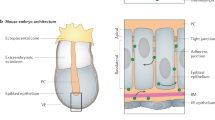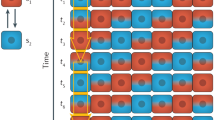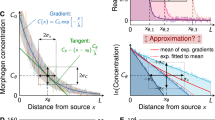Abstract
A simple order-of-magnitude calculation suggests that diffusion may be the underlying mechanism in establishing morphogenetic gradients in embryonic development.
This is a preview of subscription content, access via your institution
Access options
Subscribe to this journal
Receive 51 print issues and online access
$199.00 per year
only $3.90 per issue
Buy this article
- Purchase on Springer Link
- Instant access to full article PDF
Prices may be subject to local taxes which are calculated during checkout
Similar content being viewed by others
References
Wolpert, L., J. Theoret. Biol., 25, 1 (1969). This article, entitled “Positional Information and the Spatial Pattern of Cellular Differentiation”, should be consulted both for a modern statement of the problem and also for references to earlier work.
The basic idea of this article was presented at a lecture given to students at the Fourth NATO Advanced Study Institute of Molecular Biology in July 1969 at Spetsai.
Child, C. M., Patterns and Problems of Development (Chicago University Press, Chicago, 1941).
For a review see Lawrence, P. A., Adv. Insect Physiol. (in the press). See especially Stumpf, H., Roux Arch. Ent. Mech. Org., 158, 315 (1967).
For a review see Gaze, R. M., Growth and Differentiation, Ann. Rev. Physiol., 29, 59 (1967).
Goodwin, B., and Cohen, M. H., J. Theoret. Biol., 25, 49 (1969).
The mechanism for forming a source and a sink for ions also presents special problems, whereas for organic molecules rather simple enzymatic processes could do the trick.
The effect of temperature on the viscosity of water does not seriously affect the calculations. Taking the viscosity of water (in arbitrary units) as 1.0 at 20° C, its value at 5° C is about l½ and at 39° C is close to 2/3.
See, for example, a very ingenious fluorescent method used by Victor W. Burns (Biochem. Biophys. Res. Commun., 37, 1008; 1969) using a small organic molecule. He obtained a factor of about × 6 for Euglena. The figure for yeast was about twice this.
Lieb, W. R., and Stein, W. D., Nature, 224, 240 (1969).
This assumes that the permeability is fairly evenly distributed over the cell membrane. If it were concentrated in a small patch the effective diffusion would be slower.
For example, P for glucose in ascites cells at 37° C in about 4.5 × 10−4 cm/s ( Kolber, A. R., and LeFevre, P. G., J. Gen. Physiol., 50, 1907; 1967), or in human red cells at 37° C about 1 × 10−4 cm/s ( Millar, D. M., Biophys. J., 5, 407; 1965). Admittedly these are among the higher values of P known so far. See Stein, W. D., The Movement of Molecules Across Cell Membranes, chap. 4 (Academic Press, New York, 1967). It should be remembered that in going from one cell to the next the morphogen may have to cross two cell membranes.
An upper limit can be calculated assuming that the morphogen is an ion, that it diffuses (at 37° C) in the cytoplasm as freely as in water, that the permeability between cells is so high that it does not slow down the process at all, and that the most efficient method is used to set up the gradient. The distance then comes to 1.5 cm, but I feel that this combination of assumptions is quite unrealistic.
Piepho, H., Naturwissenschaften, 42, 22 (1955); Lawrence, P. A., J. Exp. Biol., 44, 607 (1966).
Locke, M., J. Exp. Biol., 36, 459 (1959); J. Exp. Biol., 37, 398 (1960).
The present model could be elaborated by assuming two different morphogens, one having a gradient sloping from left to right, and the other with a gradient from right to left: on this model the position of a cell would be characterized by the ratio of its concentration of the two morphogens. This particular elaboration, however, would not significantly alter any of the arguments given in this article.
Author information
Authors and Affiliations
Rights and permissions
About this article
Cite this article
CRICK, F. Diffusion in Embryogenesis. Nature 225, 420–422 (1970). https://doi.org/10.1038/225420a0
Received:
Issue Date:
DOI: https://doi.org/10.1038/225420a0
This article is cited by
-
Regulation of long-range BMP gradients and embryonic polarity by propagation of local calcium-firing activity
Nature Communications (2024)
-
Early radial positional information in the cochlea is optimized by a precise linear BMP gradient and enhanced by SOX2
Scientific Reports (2023)
-
Single-molecule tracking of Nodal and Lefty in live zebrafish embryos supports hindered diffusion model
Nature Communications (2022)
-
Regulatory mechanisms of cytoneme-based morphogen transport
Cellular and Molecular Life Sciences (2022)
-
Flags, landscapes and signaling: contact-mediated inter-cellular interactions enable plasticity in fate determination driven by positional information
Indian Journal of Physics (2022)
Comments
By submitting a comment you agree to abide by our Terms and Community Guidelines. If you find something abusive or that does not comply with our terms or guidelines please flag it as inappropriate.



